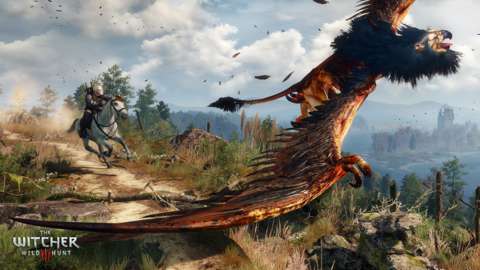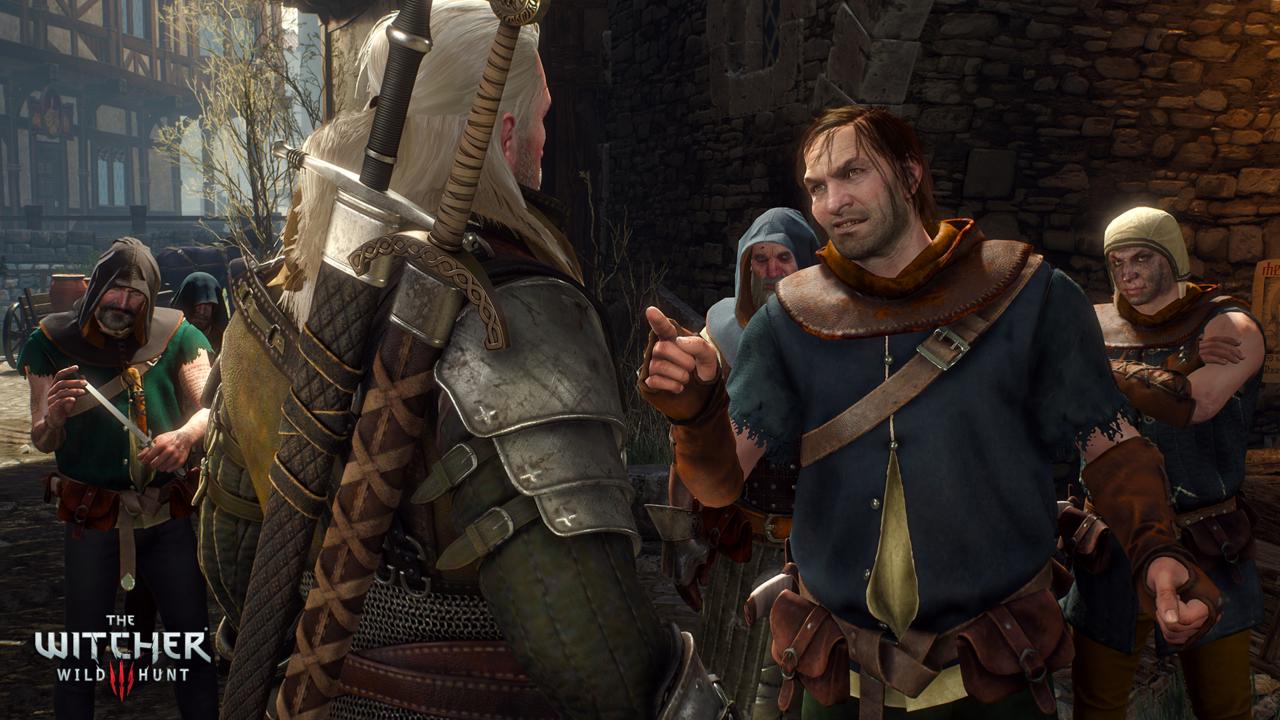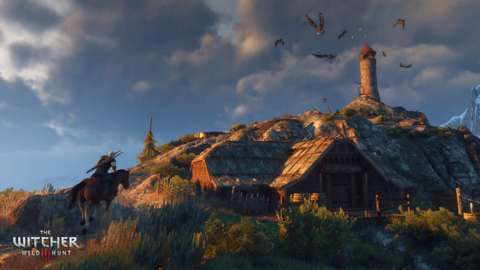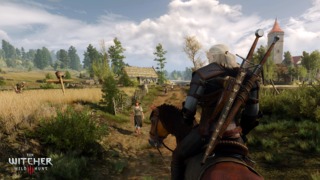Some of the best adventures in role-playing games aren't the ones the games script for you, but the ones you seek on your own. Last week in San Francisco, I joined a legion of writers eager to play The Witcher 3: Wild Hunt. Developer CD Projekt Red intended for us to play the opening hour of the game in addition to a quest that occurs later in the story. Granted, I played those bits, and I'll share what those were like as well. But the most enjoyable journey I took happened when no one was looking and I threw caution to the wind. What might be waiting out there in this huge, gorgeous world if I set out on my own?
You see, one of The Witcher's 3's vast regions is an archipelago. One of the quests I had taken took me to a nearby peninsula, but when I looked at the map, it was the islands that called to me. I had to know what I might find there--but I also had to get there first. My understanding is that there are boats to commandeer should you need to cross the water, but I saw no boats. Luckily, Witcher hero Geralt of Rivia has rippling muscles underneath the hideous scars that crisscross his body. He was more than down for the swim, which required more patience than it did effort. I swam for minutes on end--an eternity in video games, when it comes to uneventful travel--and the islands grew larger across my field of view.
Why Are Video Game Adaptations Good Now? | Spot On Fallout 4 Next Gen Update Comparison Fallout 4 Steam Deck Verified Gameplay ALIEN: Rogue Incursion - Announcement Teaser Trailer Stellar Blade - 13 Things I Wish I Knew S.T.A.L.K.E.R. 2: Heart of Chornobyl — Official "Not a Paradise" Trailer Manor Lords - Official Medieval City Builder/RTS Launch Trailer Honkai: Star Rail - "Then Wake to Weep" | Version 2.2 Trailer Devil May Cry: Peak Of Combat | Dante: Blazing Tempest Gameplay Trailer SAND LAND — Official Launch Trailer Sea of Thieves Season 12: Official Content Update Video Stellar Blade - Hard Mode No Damage Gigas Boss Gameplay
Please enter your date of birth to view this video
By clicking 'enter', you agree to GameSpot's
Terms of Use and Privacy Policy
It was when I drew close to the shore that I wondered if I should regret my decision. There were screeching Sirens diving into the water: winged and finned creatures that shrieked their displeasure at Geralt's presence. My options for attacking were limited; I was in possession of a miniature crossbow, but was wasn't sure yet how to use it. I presumed I would be safe on dry land, and managed to avoid the Sirens that were nipping at my heels. Yet the shore was not a safe haven. The Sirens emerged from the sea and soared into the air, and descended upon me like any seabirds detecting their prey might.
I was not prepared for this.
Luckily, I had gained enough levels that I could take on these flying freaks. My first tactic was to swing my silver sword at them--the sword that damages monsters in the Witcher world. Of course, swinging wildly at things that fly doesn't get much done. I could damage them when they plunged towards me, however, and the circumstance gave me a chance to try out the effectiveness of my parry. If you recall, blocking and parrying in The Witcher 2 took a backseat to rolling around on the ground, which was almost always a more effective way of avoiding damage than meeting your attackers head-on. In The Witcher 3, a well-timed parry is a great way of handling a soldier wielding a shield--or in this case, a great way of stunning a Siren swooping in to claw you. Stopping one in such a way gave me a few seconds to slash at it unimpeded before it zipped back into the sky.


Once I figured out the crossbow, the battle became even more dramatic. You can fire off a bolt without aiming, but aiming allows you more precision, as well it should. In my case, Geralt had leveled up enough that time slowed while targeting, though this ability was not a guarantee of success: I fired plenty of bolts that arced under my target because I wasn't taking the pull of gravity into account. I didn't down every Siren, but I cleared enough out of the sky that I could explore without being mocked by a half-dozen of them at once, and found a treasure chest that served as the fruit of my labor. (I don't remember what was in it; the discovery alone was enough to delight me, as were the siren battles themselves, which functioned as their own rewards.) And when it was time to jacknife into the sea and swim back to the mainland, I realized that my crossbow was effective underwater as well, and while it didn't do much damage, it bought me time as I began the return journey.
This wasn't an experience CD Projekt Red intended to showcase at t he event, but it's indicative of The Witcher 3's ability to distract you not with a dozen icons identifying where you can find "stuff to do," but with grand vistas and a real sense of wonder. I don't remember ever running into creatures that behaved like this in a game. I've seen sirens, but not ones that swam underwater and flew through the air; not ones that ensured there was no place to shield yourself from their wrath. Encountering such a thing then made me wonder what else might be out there. Knowing that there were more surprises lurking out there was enough to keep me curious--more curious than a map full of "stuff to do" is likely to make me.


Avoiding the million-and-one-icons trap is a confident design choice, though I certainly didn't run out of things to do in my three hours with The Witcher 3. I wasn't just swimming to Siren islands (or whatever they might be called), but getting involved in politics and leaping into water wells. The bit with the well was a side quest, wholly optional, but it still crammed in plenty of story and intrigue. Like the political mission that would come later, this one required me to investigate using my keen senses. The Witcher 2 also allowed you to seek loot, see footprints, and detect scents in this manner, but you can now hold a button down as long as you like to keep this special vision mode active. It's a small but subtle change that makes looking for clues a natural action rather than an annoying one. And thank goodness for that, since seeking clues related to a well-haunting ghost was all the more intriguing as a result.
A hop into the well and a bit of exploration told me what I needed to know about the spirit I had to banish. When I had performed the necessary ritual to draw her out, I realized that even my silver sword was not the only weapon I needed: my magical signs were also necessary. As before, Geralt can perform five basic signs: Aard (Force push, as it were), Quen (a magical shield), Igni (a fire blast), Axii (a charm that makes friends out of enemies for a time), and Yrden (an immobilizing trap). My sword would make no mark in the shadowy fiend unless I cast Yrden, which caused her to materialize, and allowed me to strike her through. And what a fiend she was, clad in a bride's dress and a laurel of decayed flowers. This is a dark and oppressive world, and enemies are not only frightening in and of themselves: they are symbols of the grotesque horrors that human beings visit upon each other. In this case, only a great act of violence can turn a once-vibrant young woman into such a hideous and protective ghoul. This small side story said a lot about what this place stood for, and what its people were capable of.


The aforementioned political mission at first resembled the Orlesian ball sequence from Dragon Age: Inquisition. Geralt was there to hobnob with the candidates eager to rule the region of Skellige, but he wasn't eager to participate in the social niceties, and told his host he'd rather be doing something more interesting, a line of dialogue I interpreted as a swipe at Dragon Age. (CD Projekt Red assured me it was not, but I can't help but wonder; The Witcher's writers have a proven naughty streak!) Intentional or not, the differences between The Witcher 3 and its recent competitor couldn't have been clearer. Orlesians dress in their best finery for such occasions; Skelligens prefer mead and lewd debauchery. They prefer mead a bit too much, as it turns out, for it was poisoned mead that turned some attendees into werebears, and I joined several other warriors in attendance in taking down the roaring beasts.
There were choices to be made afterwards; I could stay and investigate--but in doing so, potentially waste time--or I could chase after potential suspects and make some quick assumptions in the process. I won't spoil the outcome, but I chose to remain and seek answers, and as a result, I eventually saw my favorite candidate gifted with the crown. As much as I loved the bear fight, during which I parried, swung, and flung fire around the opulent banquet hall, I was more intrigued by the game's gender politics as demonstrated by the quest. The series has been rightfully criticized for its heavily sexualized female characters, but The Witcher 3 seems poised to address those concerns head-on, in this case with an honest approach to the troubles women face in political circles. There are plenty of strong women in this universe, but many of them are reduced to a notch in Geralt's belt. In The Witcher 3, I met plenty of women who didn't need sex appeal or magical abilities to loom large. It seems like we may finally get to remove the quotation marks from the word "mature" when talking about a Witcher game at long last.


This is still Geralt, however, and he always finds room for pleasure in this weary and decrepit place. The game opens in flashback, with a younger Geralt relaxing in a tub while his nude lover Yennefer lounges nearby. And as with The Witcher 2, The Witcher 3 never shies from the contrast between passion and rage. It's as hard to miss Yennefer's curves as it is to overlook Geralt's deep scars, which are prominent enough to make me wince. It's in this opening sequence that you also meet Ciri, Geralt's ward and a warrior-in-training herself, though she would not be subjected to the trials that leads to a true witcher's mutations. At certain moments in The Witcher 3, you will experience the world as Ciri, though just how frequently is uncertain.
I'm left thinking a lot about The Witcher 3: Wild Hunt in the week since I have played it. Its visual technology is undeniably impressive, but its the way that the technology is used that evokes such strong emotions. The lines on an older woman's face aren't just there to be there: they are there to remind us of her hardship and sacrifice. I think about its gameplay improvements: the convenience of mounting Geralt's steed, called Roach, and galloping across great distances, and the greater focus on looting and treasure-hunting, a focus enabled by a logical inventory system that replaces The Witcher 2's more cumbersome approach. Then there's the ability to eat a bit and replenish some health even when you aren't meditating. You might worry that being able to gain a bit of health during combat may assuage the challenge, but the benefit is minor, and every combat encounter I had required my full attention. This isn't an Elder Scrolls game; enemies don't seem to scale to your level, so you might need to retreat if you find yourself in over your head.
What I am mostly remembering, however, is what a strong identity The Witcher 3 possesses. You couldn't mistake this role-playing game for another. It isn't about fun as much as it is about standing up to forces that would see you dead--the forces of evil, the forces of politics, and the forces of a world so hostile that it's a wonder anything could thrive within it.

